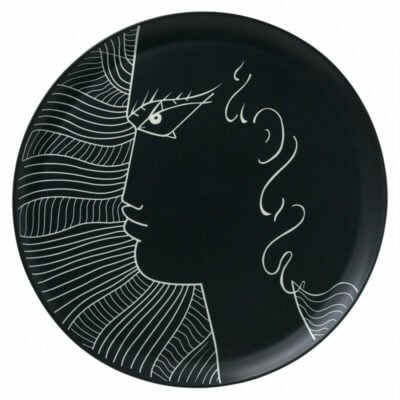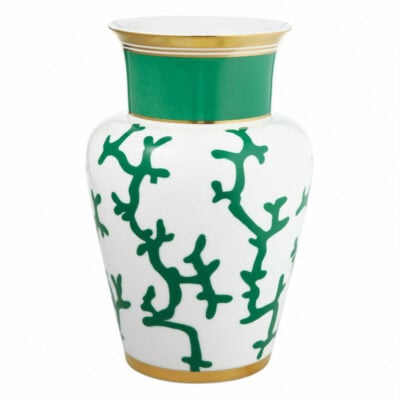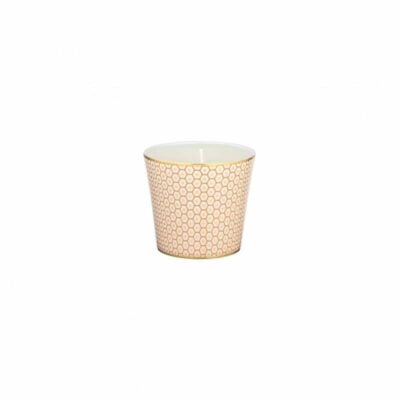Raynaud
Discover Raynaud Porcelain from Limoges: tableware, porcelain plates, vases, candles and decorative objects including the famous Cristobal Marine and Allée ru Roy collections.
A leading name in Limoges porcelain, Raynaud has continued to write its history since its creation in 1911. For nearly 160 years now, it has continued to reveal the poetic side of porcelain through a prestigious collection that demonstrates its rich expertise.
Are you a ceramic plate lover or enthusiast? Let’s retrace the steps of a porcelain maker who has been perpetuating the tradition for three generations in Limoges: Raynaud.
Enhance the tableware with unique creations featuring exclusive designs. The incomparable expertise passed down from master to student is one of the values embodied by Raynaud porcelain.
Its porcelain collection, customizable to the requirements of its highly select clientele, is engraved with a logo, initials, numbers, or a coat of arms, decorated in color or black, sandblasted gold, burnished, or inlaid patterns, and is sure to delight the elite of this world.
Also discover our selection of ceramic vases.
Raynaud Porcelain : The Story of a Family and Unparalleled Talent
A. Raynaud & Company is a French porcelain manufacturer founded in Limoges, Haute‑Vienne, in 1911. Martial Raynaud, then a travelling porcelain salesman, journeyed around the world to sell “white gold” to a clearly defined clientele of nobility and wealth. Then came his brilliant idea: to establish his own porcelain decoration workshop in Limoges.
Already renowned across Europe and the far reaches of Russia, he purchased the Montjovis factory to launch and develop his Raynaud porcelain production, becoming “Raynaud & Cie” in 1925. As the logo, he chose the letter “R” adorned with a laurel branch.
A true enthusiast at heart, Martial Raynaud has been travelling the world since the age of 20. With his rich linguistic background and incomparable entrepreneurial spirit, he passed down a creative legacy to his successors that is as rich as it is varied.
The history of the Raynaud house as a symbol of the French art de vivre begins in 1919 with the creation of Martial Raynaud’s very first “white gold” workshop. Sensitive to the artistic currents of his time, he designed artistic models in his workshops with Art Nouveau and Art Deco-inspired decorations. At the same time, he emerged as a staunch protector of Limoges’ porcelain tradition.
The factory quickly garnered a reputation for its vases and cups embellished with pearls and enamels—a style considered unique at the time, inspired by traditional Hungarian techniques that Martial Raynaud inherited from his father.
In 1952, André Raynaud took the reins of the company following his father’s passing. Also deeply passionate about art, he was just 18 when he presented two designs dedicated to the International Exhibition of Arts and Techniques in Paris, earning a silver medal—his participation a resounding success. Naturally, he assumed his late father’s position in 1952.
An accomplished artist and seasoned technician, André introduced new techniques that brought a more creative and contemporary dimension to Raynaud porcelain.
He arranged to reissue traditional collections, including “Old China” copies from the Compagnie des Indes. His daring creations testify to his talent for reinventing traditional forms into more innovative, modern lines—hence the square Raynaud plates from the “Elite” collection, now displayed at the Musée des Arts Décoratifs and the Centre Pompidou.
A big collector of vintage porcelain, André also delighted in reinterpreting the designs of his favorite pieces to enrich his collections. As curious as his father, he insisted on collaborating with renowned artists such as Salvador Dalí, Arman, Jean Cocteau, Jean‑Charles de Castelbajac, Raymond Loewy, and Carven.
By 1992, the third generation led the family business with Bertrand Raynaud at the helm. A lover of art and gastronomy, the youngest of Martial Raynaud’s five children brought the same passion as his ancestors. His curiosity led to artistic collaborations with legendary decorators like Christian Tortu (florist), Alberto Pinto (decorator), artist Hyppolite Romain, and others.
A great foodie and skillful cook, Bertrand introduced Raynaud porcelain into the culinary world by partnering with starred chefs like Thomas Keller.
Raynaud Porcelain, Design and Color
For over a century, the Raynaud house has taken a journey through time with poetic porcelain at the heart of its collection of dinner plates, soup bowls, dessert plates, tureens, coffee cups, and other exquisitely decorated pieces.
Always in pursuit of elegance and innovation, the Limoges-based factory embodies a poetic vision through its collections, where each piece tells a story. Its hallmark lies in the subtleties and blend of colors that characterize Raynaud creations.
You’ll also notice the delicate and rich motifs adorning each piece from the Limoges brand. With quality as its watchword, a piece bearing the Raynaud mark demonstrates a keen eye for detail and excellence—qualities that give life to its unique, stylish, refined porcelain. A talent now recognized worldwide.
The Raynaud house owes its current stature to the hard work of the third generation, led by Bertrand Raynaud and his wife Mariela Schwarz Montiel. In 2012, she unveiled her first collection for the company: the Trésor service. The collection quickly succeeded thanks to its feminine shapes and abundance of color.
Together, they elevated the factory on the international stage with determination, a nonconformist passion for art de vivre, a constant quest for elegance and generosity, and a desire to create a table conducive to sharing and pleasure.
From the modelling workshop to the final decorative touches, every step in the manufacture reflects the heritage of a precious tradition. From plates and platters to vases and trinket dishes, the Limoges brand has left its mark in museums and state palaces.
As proof of its artistic excellence and poetic decoration, the Raynaud house was awarded the IGP “Porcelaine de Limoges” label as a decorator, spotlighting its exceptional craftsmanship and talent as a creator and colorist.
Discovering Raynaud Expertise and the Mastery of Its Decorative Artisans
To appreciate the preciousness of Raynaud’s signature collections, one must step into the modelling workshop, where creativity and expertise vibrate in harmony.
Working closely with the creative team, the factory demands that the original model of each new creation be handcrafted by its master modellers. This long, complex step forms the foundation of Raynaud’s magnificent porcelain collections.
A “mother” mould is then formed to serve as the model for production moulds.
The moulds and tools are entrusted to an IGP‑labelled Limoges manufacturer that has worked with Raynaud for decades. There, pristine white porcelain comes to life according to precise guidelines and quality standards defined by the factory.
For decoration, Raynaud uses chromolithography. The chromist prints the design so that the artisans of the house can then apply it by hand onto each white porcelain piece.
This delicate process, in which every line and contour is meticulously chromo-covered, is essential for creating refined porcelain.
Hand-painting is another mastered technique. The painters, considered true artists, are responsible for delicate border fillets, handles, knobs, and other details on shaped pieces.
For gold or platinum decorations—the signature adornments of the factory—the pieces undergo sandblasting to achieve a smooth, matte finish.
Raynaud Porcelain and Its Collection Catalogue to Elevate Everyday Life
Magnificent symbols of refinement, these Limoges pieces by Raynaud inspire the art of the table in all circumstances. Guided by beauty, poetry, and elegance, the following creations are designed to enhance any dining occasion. They reflect the artistic richness and centuries-old know-how of the house.
The Abysses collection by Aurore de la Morinerie: In collaboration with Raynaud, the French artist and illustrator—educated at the École supérieure des Arts appliqués de Paris—continues her exploration of the ocean’s depths with this collection. Echoing the 2022 release of the Louis Vuitton Travel Book: Mediterranean Sea, these pieces capture her love of nature and travel, offering an imaginary voyage into the underwater world’s extraordinary life, inspiring elegance and finesse.
The Imari collection by Olivier Maillefer: A long-term collaborator of over 30 years, he created Imari in which Japanese pictorial art meets English decorative arts tradition. The 17‑color palette is graced with rich gold inlays. This artistic creation is notable for the delicacy of its tones and the freedom of its floral designs, all hand-painted with brush elegance. Unique and exceptional, it enshrines the Raynaud house’s signature craftsmanship.
The Mosaïc collection: Inspired by art deco and decorative art movements, this collection combines vivid colours and geometric lines. Beyond the essentials of tableware, the Mosaïc range makes an ideal gift, especially with its beautiful presentation boxes.
The Oskar collection: Just in time for spring, the Oskar service features fine ellipses in black and gold. This subtle, delicate design echoes the Bauhaus spirit, a German school that merged fine arts and craft in the early twentieth century. This exceptional service boasts four geometric motifs based on curved lines across the pieces, creating a grid both wide and compact. The chosen colors, black and gold on pure white porcelain—offer a blend of elegance and femininity, a perfect contemporary expression of French art de vivre on the table.





